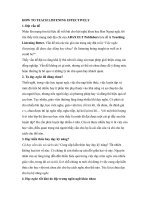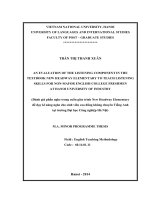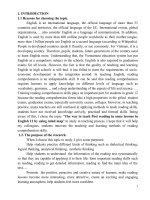Implicature and Applying the concept to teach listening and speaking skills
Bạn đang xem bản rút gọn của tài liệu. Xem và tải ngay bản đầy đủ của tài liệu tại đây (112.7 KB, 12 trang )
Implicature and Applying the concept to teach listening and
speaking skills
Author
Tran Thi Thu Trang (18.10.86), student of English M.A course 18 th, class C, in the
Department of Postgraduate Studies, College of Foreign Languages at Vietnam
National University.
Abstract
Implicature is a common linguistic phenomenon which occurs in all languages. In
English teaching classroom context, students may experience some difficulties in
interpretation of implicature in listening comprehension exercises or speaking
practice. In general, if the conversation is simple and direct, students can know
exactly what is being said through the literal meaning. In fact, however, there are
conversations in which the speakers say one thing and mean another. And we call
this phenomenon implicature.
This article first examines Grice's Cooperative principle and Maxims of
conversation as well as types of implicature and then suggests some listening and
speaking techniques and activities applying the concept "Implicature" in teaching
listening and speaking skills.
Keywords
Cooperative principle, maxims of conversation, implicature, applying the concept
"Implicature" to teach listening and speaking skills.
Introduction
Students today are demanded with full competence of English. Understand what is
being said and communicate successfully are core requirements for most students.
In the context of English listening and speaking classrooms, it is important for
teachers to develop students' competence to understand the real meaning of what is
being said when exposed to a short conversation and then they can take further
action- to make a choice, filling the blanks, or answer the questions. More
importantly, this can assist students to improve the speaking skill. In conversation
we usually understand what is said directly and straightforwardly. That is we base
on the original or literal meaning of the words. But there are cases that seem the
conversation is expressed indirectly, so students cannot make the right judgment if
they only consider its literal meaning. The two following examples will illustrate
the point:
Exchange 1:
Jack: Did you enjoy Animal farm?
Lyly: No, I don't.
Exchange 2:
Jack: Did you enjoy Animal farm?
Lyly: I only like detective stories.
In the exchange 1, Lyly gives the direct and relevant answer to Jack's question, and
the listener is easy to infer the meaning : They are talking about a story and Lyly
does not like it. In the case of the exchange 2, the two speakers are also talking
about the story but Lyly does not give the direct answer to Jack's question instead
by suggesting another topic. It seems quite irrelevant in the surface structure level
as far as the question- answer is concerned. If we believe that the two people in the
conversation are cooperative and that their conversation is meaningful, we would
assume that the answer must be relevant to the question and we need interpret more
than the literal meaning of the sentence by applying the other way round. Here Jack
puts what Lyly has said together with other piece of information he has and he
comes up with a new piece of information. The process is:
What Lyly said: Lyly only likes detective stories.
Jack know that: Animal farm is not a detective story.
Therefore: Lyly does not like Animal farm.
So for the listeners in listening comprehension as well as speaking classroom, it is
most important that they should be aware the two speakers in a conversation is
observing one common principle—the Cooperative Principle (CP), which
generates the meaning of the whole conversation: sometimes obvious and direct;
sometimes implied and expressed in a round-about way- It is called implicature.
We find that implicature is a common phenomenon in daily conversations. Most
students have difficulties in indentifying conversational implicatures. However,
implicature is not officially mentioned as a techniques in teaching English,
specifically, in teaching listening and speaking skills.
Cooperative principle and Maxims of conversation
Grice's first insight was that there might be some general principles behind how
hearers retrieve implicatures. This basis idea was this: communication is a
cooperative activity, so when two people are communicating, it is in both their
interests to make the communication go as smoothly as possible in order to achieve
their mutual aim. But what counts as being cooperative? Grice's answer to this
question is that speakers follow a general cooperative principle. It is defined as
follow:
" Make your contribution such as is required, at the stage at which it occurs, by
the accepted purpose or direction of the talk exchange in which you are engaged"
This implies that you need not and should not supply information which you can
assume that your audience already has- just as suggested by the principles of
necessity and sufficiency. The Cooperative principle can be broken down into a
number of different maxims of conversation, which fall into four basis categories:
Maxims of quantity ("say just as much as is necessary"):
Make your contribution as informative as is required for the current
purposes of the exchange.
Do not make the contribution more informative than is required.
This maxim means that the speaker/writer has to include all the information that the
addressee requires to understand. If the speaker leaves out a crucial piece of
information, the addressee will not understand what the speaker is trying to say. But
it is not necessary for the speaker/writer to provide the information that is not
necessary or required.
Example on the maxim of quantity:
Mum: Did you finish your homework?
Pat: I finished my algebra.
Mum: Well, get busy and finish your English, too!
The child did not say that her English homework is not done, nor did she imply it.
Nevertheless her mother is entitled to draw this conclusion, based on the
combination of what the child actually said and the cooperative principle.
Maxims of quality ("tell the truth"):
Do not say what you believe to be false.
Do not say that for which you lack adequate evidence.
Example on maxims of quality:
A: Should I buy my son this new sports car?
B: I don’t know if that’s such a good idea. His record isn’t so great.
B’s answer is truthful and it is supported by evidence.
Maxims of relation ("stick to the point")
Be relevant.
Relevance is an extremely important principle in linguistics. In the context of
Grice's Co-operative principle, the demand for relevance simply means that the
speaker/writer should only include information in his communication that is
relevant to the discourse topic. It is interesting to observe that the perceptions of
what is relevant and what is irrelevant diverges among people. This shows that
relevance is a matter of degree, not something absolute. In linguistics that is quite
typical. Hardly anything is set in stone, almost everything is a matter of degree or
statistical frequency. This is also a problem with Gricean approach. What exactly is
relevance? What makes one contribution relevant and another not? Grice himself
was acutely aware of this vagueness in what it is to be relevant but never him came
up with a precise formulation.
Example on maxims of relation:
A: How are you doing in school?
B: Not too well, actually. I'm failing two of my classes
B’s answer is relevant
Maxims of manner ("be clear")
Avoid obscurity.
Avoid ambiguity.
Be brief.
Be orderly.
Example on maxims of manner:
- John got into Columbia and won a scholarship.
“and” means that both linked events occurred, but implicates also
temporal progression due to the maxim of manner: be orderly.
Classification of implicature
In the above we have had a full discussion about Grice’s Cooperative principle and
the its maxims. We see that in any kind of conversation it’s usually the case that
both the speaker and the listener will observe the Cooperative principle. However
these maxims are not always fulfilled. A speaker may quietly violate a maxim, he
may be faced with a clash between different maxims, or he may flout a maxim in
such a way that the listener can be assumed to understand that this is being done.
The latter case is especially interesting since it gives rise to a "conversational
implicature" that is at variance with the literal meaning of the utterance. In such a
case, the speaker is said to "exploit" a maxim.
Implicatures: A special case of situations in which the perceived meaning extends
beyond the literal meaning.
"It is clear that implicature plays a major role in language change, triggering both
syntactic and semantic changes. Indeed it seems to be one of the single most
important mechanisms whereby matters of language usage feed back into and
affect matters of language structure. [Levinson, p. 166]
According to Grice and Yule (1998), implicatures are classified into two main
types:
Conventional implicatures which is additional unstated meaning associated with
the use of specific words such as but, and, therefore, even, yet, or. Therefore, we
can draw out that conventional implicatures are not based on cooperative principle
or maxims and independent from the context for their interpretation. For instance,
George is short but brave. (contrast)
Sue and Bill are divorced (conjunction)
He jumped on his horse and rode away. (sequence)
I dropped the camera and it broke (consequence)
Conversational implicatures which are inferred via the cooperative principle or
maxims.
Example:
A: I am out of petrol.
B: There is a garage around the corner.
Grice also distinguishes conversational implicatures that depend heavily on context
or occasion ("particularized conversational implicatures") from those that do not
("generalized conversational implicatures"). According to Yule (1998) the former
are inferences which are required to work out the conveyed meaning…when our
conversations take place in very specific contexts in which locally recognized
inferences are assumed . The latter, no special knowledge is required in the context
to calculate the additional conveyed meaning. The two following examples can be
seen as illustration:
Exchange 1: Doobie: Did you invite Bella and Cathy?
Mary: I invited Bella.
So Mary means that she did not invite Bella generalized conversational
implicature
Exchange 2:
Rick: Hey, coming to the wild party tonight?
Tom: My parents are visiting.
Tom implies that he cannot come particularized conversational implicature.
Classification of conversations that involve in implicature in listening
comprehension
We have talked about the Cooperative principle and maxims in the above section.
In listening comprehension (either in examinations or in the classroom), students
somehow are having difficulties in interpreting the conversational implicatures
from the dialogue they hear. The same situation also occurs in speaking classroom.
Imagine that you were in a conversation with others and you would not understand
what they mean, then the conversation would be failed.
In English listening comprehension, as far as the conversation are involved, they
fall into several categories:
The first one are those that observe the cooperative principle very strictly and are
easy to infer the meaning. For example,
A: I'd like to buy some fruit.
B: Which fruit do you want?
In this example both the speakers are very cooperative and the answer to the
question is relevant and informative enough to provide the sufficient information
that the first speaker needs. To these kinds of conversation it is not a difficult task
for the both the students and the teacher.
The second one are those through the flouting of CP maxim(s) there evokes the
conversational implicature that listeners should try hard to interpret. The types of
conversation that need to be interpreted to figure out the implicature includes
(Laurence F.B, 1999):
1. Relevance
A: How about going for a walk?
B: Isn’t it raining out?
2. Indirect criticism:
The Indirect Criticism implicature often follows a request for an evaluation of
something. When expressed using this implicature, the evaluation is negative. That
effect is achieved by praising some unimportant feature of the item being
evaluated, thus implying that there is nothing more flattering that can be said. For
example,
A: Have you seen Robin Hood?
B: Yeah. I went last night.
A: What did you think of it?
B: The cinematography was great.
A: Oh, that bad, hug?
3. Sequence-based implicature
Sequence-based implicatures are based on the assumption that unless there are
indications to the contrary, events being described occur in the order in which they
are expressed. The effect of this assumption is easily seen in the difference in the
sequence of events implied by sentences such as :
Jack drove to Chicago and had dinner.
Jack had dinner and drove to Chicago.
4. Irony:
For example:
Context: Bill and Peter work together in the same office. They sometimes are sent
on business trips together and are becoming good friends. They often have lunch
together and Peter has even invited Bill to have dinner with him and his wife at
their home several times. Now Peter’s friends have told him that they that they saw
Bill out dancing with Peter’s wife recently while Peter was out of town on a
business trip. On hearing this, Peter’s comment was…
Peter: Bill knows how to be a really good friend, doesn’t he?
Applying the concept "Implicature" to teach listening and speaking skills
In English classroom, the importance of interpreting the conversational implicature
is obvious. For the teacher, his/her major task should not be just finish the class by
letting the students listen to the materials again and again and then provide the
correct answers to the questions. Instead the toughest part of the job is that how to
support the students in the process of listening and speaking, and how to develop
the competence of implicature interpretation in English classroom. This part
presents some listening and speaking techniques and activities with the hope that
they can assist students in interpretation of implicature.
First of all, teachers should explain what implicature is, try to make explanation
simple enough and avoid using linguistic terms.
For teaching listening comprehension, teachers should
Choose authentic material: Authenticity should be evident both in language and in
task. The language should reflect real discourse, including hesitations, rephrasing,
and a variety of accents. Use of authentic material, such as workplace training
videos, audio tapes of actual workplace exchanges, and TV and radio broadcasts,
increases transferability to listening outside of the ESL classroom context--to work
and to community.
Prepare learners psychologically for the listening activity, telling them that they
will not be able to understand everything they hear, and that they should not panic
because of this.
Engage the learners in pre-listening activity: This activity should establish the
purpose of the listening activity and activate the schemata by encouraging the
learners to think about and discuss what they already know about the content of the
listening text. This activity can also provide the background needed for them to
understand the text, and it can focus attention on what to listen for.
For teaching speaking skill, teacher should create teaching activities for all kinds
of implicatures from easy (generalized) to difficult (particularized). These activities
can be conducted these in class or some can be given as homework if the time is
limited.
Here are some speaking activities applying the concept "Implicature"
Activity 1: Ask a student to tell the class a short funny story, or, especially, a short
funny conversation. Then, ask students to analyze the reason why it is funny.
Activity 2: Ask some pairs of students to compose a short conversation which will
make the class laugh. The class will vote which is the best. Students have to
rehearse the conversation very naturally, including raising or lowering their voice.
This activity will help students to speak English more naturally.
Activity 3: Ask two students to compose a short conversation in which the answer is
not allowed to be direct from the question. Then, another student is asked to guess
what the answer implies.
Activity 4: Let students read a humor story which violates one of the four maxims;
then ask the students why the story cause humor.
Activity 5: Ask students to listen to some short conversations in which participants
imply something behind the language used. Then, ask students what participants in
each conversation means.
Conclusion
According to Grice, conversational implicature plays an important role in our
personal interactions. This article reviews the theory which explains how we
correctly interpret what others are implying in conversations, that is Cooperative
principle and maxims of conversation. The concept "Implicature" and its types are
also stated quite clearly. Although the role of implicature in communication is
undeniable, it is not paid appropriate attention in teaching listening and speaking
skills to EFL students. Therefore, this article mentions the classification of
conversations that involve implicature in listening comprehension and suggests
some listening and speaking techniques and activities that would be helpful in
English classroom context. It is hoped that these will make the lessons more
interesting and students can improve their listening and speaking skills.
References
1. Anderson, A & Lynch. T.,1980, Listening. Cambridge University Press.
2. Mustafa Shazali Mustafa, The Interpretation of Implicature: A Comparative
Study between Implicature in Linguistics and Journalism Journal of
Language Teaching and Research, Vol. 1, No. 1, pp. 35-43, January 2010,©
2010 ACADEMY PUBLISHER Manufactured in Finland.
3. Levinson, S..C., 1995, Pragmatics. Cambridge University Press, United
States.
4. Lewis, Marilyn. 2003, Study skills for speakers of English as second
language, Basingstoke.
5. Yule, G., 1998, Pragmatics. Oxford University Press, London.








